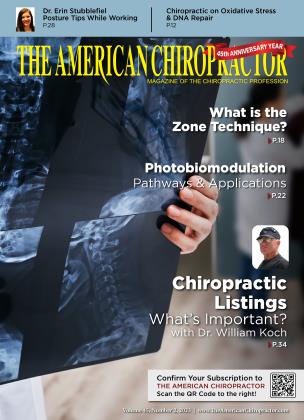from Interrupting the Work-Life Balance
February 1 2023 Erin Stubblefieldfrom Interrupting the Work-Life Balance
February 1 2023 Erin StubblefieldA poll conducted by Forbes Health in May of 2022 asked a very poignant question: “What is an important aspect of your job?” Ninety percent of the respondents listed “work-life balance.”1
Work-life balance is not new, but if the last several years have taught us anything, it’s that the line between the two has been a bit blurry. As millions of people — our patients — transitioned to working from home because of the COVID-19 pandemic, not only were the lines between work and life hazy, but it also led to a host of issues because of a semi-forced, sedentary lifestyle.
How many of these patients did you see in your office during the spring and summer of 2020? How many new cases of headaches and back pain did you treat because of patients saying, “I’m working from my home office, which is also my kitchen table”?
Between 85-92% of back injuries are a result of everyday postural stresses/non-traumatic stressors.2 With so many jobs requiring long hours of sitting and working at a computer, proper workstation ergonomics are vital to maintaining good posture, thus minimizing the stress that poor posture can cause for your patients.
Proper, Ergonomic Posture Is Important for Several Reasons
•Keeps us “in place.” Our spinal joints are very important in overall stability. If we are slouched or antalgic to one side or the other, the ligaments that support our spine are at a greater risk of injury. Proper posture helps stabilize our spine and reduces the likelihood of a ligament-related injury.
• Allows for more efficient coordination with muscle movements. Poor posture can cause inefficient gross muscle movement patterns that use more energy than is necessary. This can lead to premature fatigue or muscle burnout.
•Prevents muscular pain and excessive wear and tear on joints. A “poorly” relaxed body lacks stability. As previously stated, almost all back injuries are due to postural stress. This means our patients may get back pain after only an hour of sitting (in an eight-hour day!) simply due to poor sitting posture and muscle fatigue. Poor stability can also cause joints to wear down faster, leading to conditions such as arthritis.
Let’s look at head posture as an example.
When the head is properly over the shoulders, the muscles, bones, and tissues of the neck are in a neutral position, which allows for full mobility of the neck with less incidence of pain.
As we stare down at computer screens all day, our head slowly starts to jut forward. This changes the position of the supporting muscles of the neck and puts an increase on the pounds of pressure exerted on the cervical (neck) vertebrae. In fact, it is estimated that for every inch of forward head posture, 10 additional pounds of force are exerted onto the neck muscles and other structures. Considering the average head weighs 10 pounds, even 1 inch of forward head posture can double the stress on the neck.
Over time, the effects of forward head posture can include:
• Muscle pain and fatigue
• Loss of range of motion of the neck can lead to a feeling of stiffness and pain
• Headaches
• Jaw pain
• Shoulder pain
• Early degeneration or disc disease
• Issues with vision and mental clarity3
Can you imagine how difficult work is with any of these symptoms? How can we expect patients to have fulfilling lives outside of work when work is causing pain?
These are the items to look at when assessing your own posture:
• Chin parallel to the floor
• Shoulders even
• Neutral spine
• Arms at sides with elbows straight and even
• Abdominal muscles braced
• Hips even
• Knees even and pointing straight ahead
• Body weight distributed evenly on both feet4
You might wonder what role the feet play in this “posture picture.” A supportive foundation helps the body deal with weight and pressures exerted through the feet. Without it, the forces that can transmit through the feet and up the kinetic chain can be significant. Even at rest, the feet accept proprioceptive input from whatever is underneath — the ground, shoes, etc. It isn’t hard to imagine then that supporting the feet can enhance and stabilize posture, which can lead to less overall spinal discomfort or pain.
Custom flexible orthotics alone have been shown to reduce back pain by more than 34%.5 Additionally, custom orthotics have been shown to increase function — activities of daily living such as sitting, standing, walking, social and personal activities, and so on — by over 30%!5
What does this mean for our patients? If they are in pain because of work, the work-life balance will suffer. By focusing on proper posture and including custom flexible orthotics with your chiropractic care, you can support your patients from the ground up and empower them to get out and enjoy life!
Dr. Erin Stubblefield is a 2006 graduate of Palmer College of Chiropractic in Davenport, Iowa. After years of private practice in Illinois, she moved to full-time teaching in Overland Park, Kansas, a suburb of Kansas City. Dr. Stubblefield is an associate professor, author, and presenter. For additional information, she can be reached at [email protected].
References
1. https://www.forbes.com/health/...
2. https://www.iasp-pain.org/reso... -back-pain/
3. https://www.physio-pedia.com/F...
4. https://www. health, harvard, edu/staying-healthy/why-good-posturem after s
5. https://www.footlevelers.com/p...
 View Full Issue
View Full Issue






